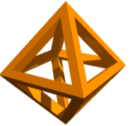
Gorka Lasa, poetics as a philosophical feat.
Lars Sørensen
Gorka Lasa, a Panamanian poet born in 1972, is an atypical figure in contemporary Latin American lyric, his unusual work stands as a testimony of the human soul faced with the vertigo of its own transcendence. His poetry, profoundly mysterious, symbolic and evocative, dialogues with the metaphysical tradition of literature, exploring the boundaries between the visible and the ineffable, between the temporal and the eternal.
Lasa appears as a hieratic voice, a kind of alchemist whose work deciphers the riddles of a neo-gnostic worldview and a cosmic paradigm in gestation. His poetry transcends the limits of the ordinary, projecting itself into a space where language works as a mediator between the microcosm of the individual and the universal macrocosm. In this sense, Lasa is an architect of symbols, a weaver of meanings, at times hermetic, at others dense and prophetic, Lasa connects ancestral spiritual traditions with the deepest questions of contemporary philosophy.
His work can be understood as a spiritual journey that travels through the inner landscapes of the being. In his verses, language is not limited to being a communicative tool but is transformed into a vehicle of revelation. His poems are spaces where the fragmentary becomes totality and the everyday is transmuted into mystery. The word, purified to its essence, seems to encrypt a secret that summons the reader to decipher it in the realm of his own interiority.
Lasa's poetic proposal is based on his subtle ability to reveal hidden truths. In most of his poetry publications, a polar tension stands out, an emphasis on duality (as an obstacle to transcendence) that seems to configure not only an emotional experience, but an ontological axiom: the human being, suspended between the dynamism of becoming and the immutability of Being, finds in the poetic word an access to the "cosmic substratum", as a primordial vibration that resonates in all things.
Gorka’s literary proposal not only evokes powerful images, but also proposes a framework of thought where oppositions are reconciled in a dialectical movement, close to the proposals of Hegel and his Aufhebung. This dynamism is also reminiscent of the ideas of Deleuze, who interprets difference as a creative force and not a lack, something that resonates in Lasa's poetics by presenting cracks and wounds as places of opening and transit to the transcendent.
The titles of his books are also suggestive and preambular, such as "Aldebaran, the vertigo of eternity", "Some of us forever", "The balance of the hemispheres" and "The Ancient Immensity of the Wound", evoking an irresolvable anguish between opposites: movement and calm, wound and immensity. This polarity is a constant in his work, a reflection of the duality inherent in human existence. His poetry inhabits the threshold between "being" (with a lower case) and "Being" (with a capital letter), that territory where reason and spirit converge, and which, from the voice of the wounded poet who has recalled the origin, reveals in his song a longing for totality that is never fully consummated. From this perspective Lasa's work dialogues deeply with the structures of neo-gnostic thought, understanding the world as a space of separation and exile, but also as the stage where the divine spark can be rediscovered. A search for the "lost truth" is perceived as a central idea both in gnosis and in various esoteric traditions such as kabbalah and neoplatonism. Here, language is a vehicle of redemption, but also a sign of the fragmentation of the One.
“The wound, its eternal night, flaming song in the abyss and its rupture
an amalgam of amber clouds over the horizon of the last depth.
Ancestral litany, distant hymns of a sun that fell asleep
uncanny phase, rock that waited for eons the judgment of its hardness.
Humid realm of melancholy, delirious sunset, the lonely star.
That is where my poems are conceived
In the ancient immensity of the wound.”
Gorka Lasa's poetry encapsulates a vision where human suffering is not an isolated event, but a reflection of a shared cosmic ontology, a notion that connects with Teilhard de Chardin's ideas about the spiritual evolution of the universe. Lasa's work also aligns with the symbolist tradition in terms of its ability to suggest and evoke beyond the explicit. An example would be the recurrent use of words such as "emptiness", "silence" and "light", which in Lasa are not mere poetic elements, but emblems of an intuitive knowledge that escapes rational language. This approach finds echoes in the philosophy of Heidegger, for whom language is the "house of being", but also in Derrida, who points out its always incomplete and deferred character.
I’m inclined to think that in its entirety, Lasa's work is not simply a meticulous and mantic literary exercise, but a cartography of the human soul in the face of the vastness of being. His poetry invites the reader to take part in a communion with a neo-gnostic wisdom that does not deny the world, but redeems it through contemplation, realization and language. Lasa, as a poet/messenger of a new cosmic paradigm, is inscribed in the tradition of visionary poets, who as; Hölderling, Rilke, Blake or Valente, find in the word the means to draw the bridge between the finite and the infinite. In his verses, poetry is not only art, but revelation: a conscious, profound and conjured act to try to anchor the memory of the eternal in time.
Gorka Lasa does not write to offer answers, but to awaken the impulse of search through the reformulation of the fundamental questions about the nature of being and its relationship with the cosmos. His poetry is an initiatory exercise of contemplation and transcendence, an invitation to take part in the ritual of the eternal in the transience of the word. Reading it, one cannot help but feel called to that mystery that beats beyond everyday experience, where time is suspended, and the being faces the abyss of its own immensity.
Uppsala, Sweden. October 2024.
